L’ISLE-SUR-LA-SORGUE – THE ANTIQUES CAPITAL OF PROVENCE
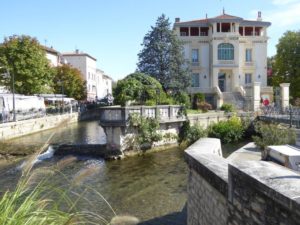
Many of the towns and villages of Provence have something quite individual that has defined what they have become and what they are known for. Some have marvellous Roman ruins, stunning views, or perhaps a medieval fortress or two. L’Isle-sur-la-Sorgue is one of our must-visits and we often plan our itinerary around its most famous attraction—the Sunday market which takes over the entire historic centre of town. However, there’s even more to discover in this totally charming town, and if you’re interested in antiques or simply a vintage treasure to decorate your home, this is the town for you.
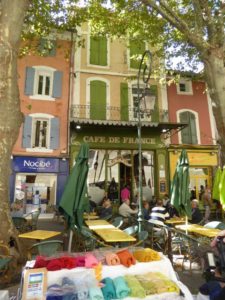
L’Isle-sur-la-Sorgue (The Island on the Sorgue) is one of the prettiest towns in Provence, with huge, overhanging plane trees and cool, green streams. It’s a delightful, sunny town full of charming restaurants, bars and cafes and a buzzing atmosphere. Located at the foot of the Vaucluse plateau on the plains of Comtat Venaissin, it’s only 7 kms from the lovely village of Fontaine-de-Vaucluse where the river Sorgue has its source. The river itself is around 30 kms long, and passes by L’Isle-sur-la-Sorgue to Avignon where it joins the Rhône.
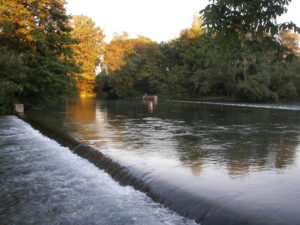
Where the river Sorgue splits into two smaller streams, L’Isle-sur-la-Sorgue sprang up. Over the last half-century thereabouts, the town has become famous as the antiques capital of Provence—and indeed of France, if you don’t count the vast Marché aux Puces in Paris.

There are many permanent antique and bric-a-brac shops, small art galleries and any number of interior décor shops here, grouped into several quartiers of the town. The Sunday market is the big drawcard, when the entire historic centre of town becomes an orgy of market stalls, selling anything from genuine antiques, the merely “pre-loved”, and anything-in-between, roughly over 300 such vendors.
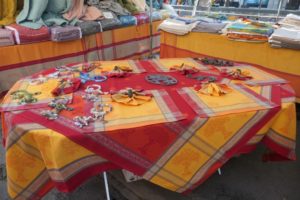
There are also many food stalls, ranging from fresh, farm produce to honey, herbs and spices pre-packaged or loose, as well as vendors selling fresh flowers, olive-wood bowls, platters, salad servers and the like, leather workers selling their own hand-made belts and bags, fashion stalls with a good range of lightweight linens for women and men, and the expected stalls selling a great range of fabrics, both in rolls, or made up into table linen or cushions. We have quite a collection of Provençal-print place mats and napkins from this market—they’re irresistible! Totally irresistible, especially when you see the prices and do a mental calculation comparing these prices to those back home.
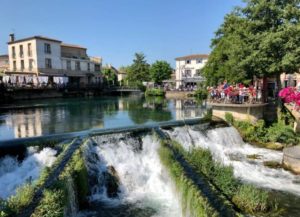
All of this is simply the current face of L’Isle-sur-la-Sorgue, but it doesn’t hint of its past, and how the town came about. It’s history is all down to the crystal clear emerald waters of the canals of the river Sorgue that flow through and around it, so shallow and calm now, enough that you can see the trout lazing in the sun. Yet it was powerful enough to have brought industry, wealth and the fine architecture and the populace that came with it.
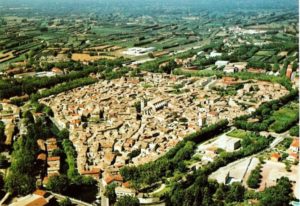
During the Middle Ages, the entire region was an enclave within the Kingdom of France, comprising the city of Avignon (itself always a separate comtat), roughly between the Rhone, the Durance and Mont Ventoux. The region, or Comtat, was the possession of various Counts of Toulouse, and the Counts of Poitiers. It was bequeathed to the Holy See in 1271 and became a Papal territory in 1274. Formed at the close of the 13th century, the town was called ‘Insula’, and was the smallest of the communities of the Comtat Venaissin.
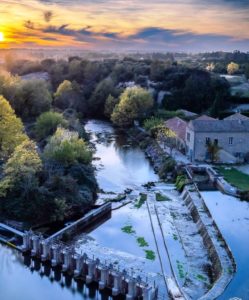
The drainage of wet soils in the Middle Ages enhanced the rich alluvial lands of the surrounding area. The town grew, and as early as the 12th century the river served defensively as a moat around ramparts powerful enough to repel the bands of road users who travelled through the region during the Hundred Years war, and the troops of the terrible Baron des Adrets during the Wars of Religion. These ramparts surrounded the town until 1795, and were demolished during the Revolution. On Place Ferdinand-Buisson near the Tourist Bureau on Place de la Liberté, you can see an austere, ancient stone tower, La Tour d’Argent which dates from the 12th century, that once formed part of the town’s defences.
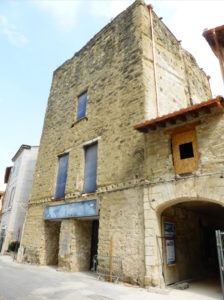
The town had a consular regime, like the Commune of Avignon, which it kept until the Revolution. During the Revolution, the moderate and conservative townsfolk took sides with the Girondins and the Fédéralistes against the Parisian revolutionaries. The town was stormed by Jacobins’ troops, looted and burned, and placed under siege until 1801. It was named L’Isle-sur-la-Sorgue in 1890.
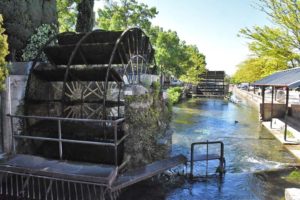
The river also served as a source of food and industry: fishing and artisan mills for oil, wheat, silk, papermaking, woollen mills, rugs and textile dyeing. Combing, spinning and weaving were initially done manually. Hydraulic energy was exploited from the Middle Ages and in 1453 permission was granted to build a water wheel on the Sorge de l’Arquet, where that branch of the river flows southwest through the centre of town. The very picturesque Roue (Wheel) de la Porte d’Avignon was built around 1530. A busy commerce developed until there were two annual fairs and two weekly markets.
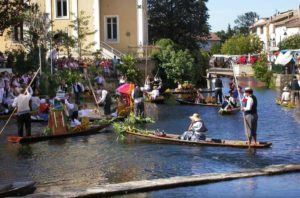
The current outdoor market originated on 09 November 1596. The river provided the energy to drive up to 70 wheels by the 19th century. The activity of the small mills declined in the 20th century, but the memory of this period is maintained by the local people and remains alive, and it seems that the town still lives to the rhythm of its river, where the murmur of water is never far away.
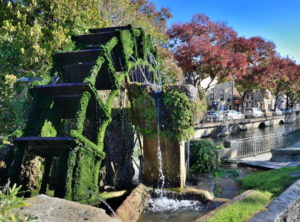
There are still about 17 – 20 paddle wheels left in the town. Today, some of them still turn, and it’s a fascinating sight, watching the heavy, foaming blades, filled with the clear water of the Sorgue, move slowly, and as they ascend, they glisten in the bright sunshine. If you’re curious to see more, the Office de Tourisme—itself worth seeing, as it’s housed in an old granary—has a handy little walking tour map showing where 15 of them are located in and around the town, with maybe 3 or 4 others on the outskirts.
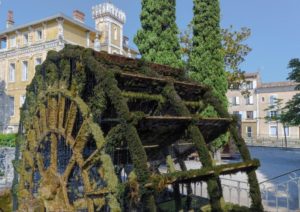
This map numbers the wheels and gives the name and a brief history of them. The walk takes about an hour and a half, and provides a good initial visit around the old town. If you visit Fontaine-de-Vaucluse you’ll see a few more water-wheels, and there’s the occasional wheel along the length of the Sorgue, and even some 18th century water wheels that remain in the centre of Avignon. No matter what time of year you dip your toes into the river or canals, the water will be always around 13 degrees, which is the temperature it shoots out of the earth at its source at nearby Fontaine de Vaucluse.
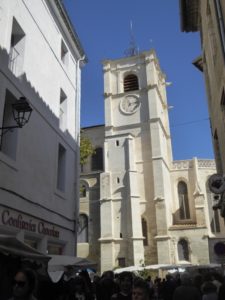
The imposing Notre-Dame des Anges church in the historic centre was a Collegial church constructed in 1212 and consecrated in 1222. Rebuilt in the 17th century, 3 sides still show signs of its age, the front has been partially re-built and restored, and includes a lovely clock showing the time, date and phases of the moon. It has been a listed historic monument since 1911. Gargoyles around the top of the church are a reminder of the Medieval period, and the cleaning and renovating of them in 2009 has left some nicely detailed ones to see today.
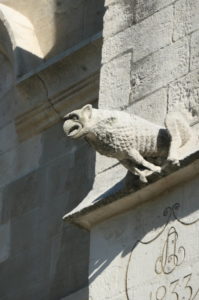
The church is a good venue for classical music concerts on summer evenings, which you can combine with an alfresco dinner in the square. The church is surrounded by cafes and shops, and the many shopping streets radiating out from this centre have mouth-watering smells and enticing window displays.

Many magnificent mansions have been converted into commercial premises and particularly a few good art galleries, notably the highly regarded Maison René Char, occupying the 18th century Hotel Donadei de Campredon. This mansion is now a museum exhibiting such great artists as Miro, Maugin and Raoul Dufy, as well as a display area dedicated to French poet and member of the French Resistance, Rene Char (who commanded the Durance parachute drop zone during the war), who was born in L’Isle-sur-la-Sorgue in 1907. Although he refused to publish anything during the Occupation, Char wrote a volume of prose poems during this time, dealing with resistance, which was published in 1946. In the 1960s he joined the battle against the stationing of atomic weapons in Provence. He died in Paris in 1988.
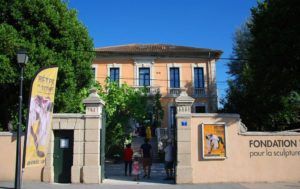
Another fine 19th century mansion in town that has been converted into a gallery is the Villa Datris. Once the home of Albert Gassier, one of the founders of the antiques fair in L’Isle-sur-la-Sorgue, it was transformed in 2011 into a foundation dedicated to contemporary sculpture. The foundation has established itself on the calendar of cultural events in the region and presents a new exhibition of works each year, but aside from showing contemporary artists’ work, you can also see works by Miquel Barceló, Fernard Léger, Picasso, Le Corbusier, Sol Lewitt, Joan Mirò and Jean Nouvel. Admission is free, and the gallery is located on Ave. des Quatre Otages—ask the Tourist Bureau to mark it on your town map.
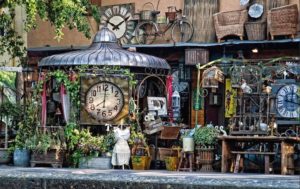
As mentioned, the main drawcard for many people to L’Isle-sur-la-Sorgue is its antiques and brocantes (more accurately, some referred to as simply second-hand goods) traders. The permanent brocantes are to the south of the town centre, in particular near the train station to the south-west of the town centre.
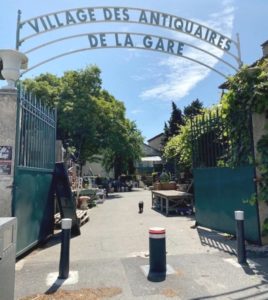
This is the Village des Antiquaires de la Gare, at 2 bis Ave. de l’Egalité, a unique place which houses around 100 galleries, grouped in 110 spaces, to offer period furniture and objects in a variety of styles. It’s open all year round from Friday to Monday. This particular space is the largest and oldest in town for antiques and bric-a-brac, and its housed in a former 19th century spinning mill. In 1978, Jean Nicolas and Pierre Rougon, art enthusiasts and owners of a former spinning mill, had the idea of offering professionals the opportunity to settle and establish themselves in a permanent location, in order to enhance and grow the economy of the town.

Each Sunday morning from 8.00am to 6.00pm you’ll find the Flea Market on Av. Des 4 Otages. Rather less serious than the Antiquaires de la Gare, there’s usually quite a carnival atmosphere and this is regarded as one of the best antiques/flea markets in France.
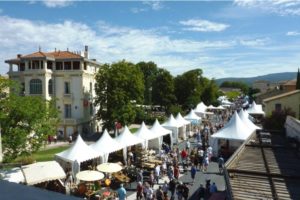
There’s an old book market held on the last Sunday morning of each month on the esplanade Robert Basse, and the International antique and flea market fair is held at Easter and again in August.

For many of us though, wandering through the busy lanes of the town on one of the two market days brings enough delights to the eye by way of both bric-a-brac traders selling their wares and the vendors typically found at authentic Provençal markets—local produce, bread, olives, colourful local Provençal ceramics and pottery, and of course, anything made from lavender.
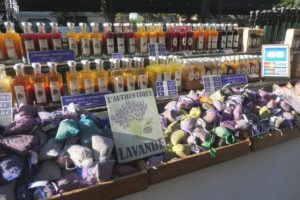
As well, up and down the streets in the areas which aren’t hosting the traditional market stalls, there are countless shops and back alleys filled with antique shops, vintage stores and some very appealing home décor stores.

L’Isle-sur-la-Sorgue has a good range of accommodation in and around the town, and needless to say, plenty of cafes, bistros and local restaurants, many of which feature fresh, local seafood.

It’s a town with much to enjoy, and definitely worth at least an overnight stop-over to explore the numerous attractions of the town as well as the fabulous markets. We usually arrive on a Saturday and stay overnight, which puts us in the best place to sally forth bright and early for the Sunday market—one of the highlights of a visit to the Vaucluse region of Provence.
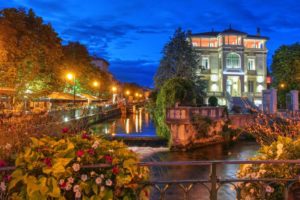


Love your stories Cheryl . Thankyou .
Amanda Menogue
Hi Amanda,
Thank you for your very kind words–I’m so pleased you enjoy them!
Best regards,
Cheryl
Thanks. Cheryl. Sounds a definite “ must “ to visit .
Cheers, Lois
Hi Lois,
If you’re planning on visiting Provence, yes, I would absolutely put it on your Must Visit list! Check out its location on a map of the region and you’ll see that it’s quite close to many other towns and sights, such as the Luberon villages etc. and larger towns such as Avignon, making it an easy addition to an itinerary. One thing though, if you planned on staying on the Saturday night in order to be well-placed for the Sunday market (which is a very good idea) you need to book accommodation as soon as you can. It’s fun destination! Regards, Cheryl
Another very interesting essay Cheryl. Thank you. Sarah
Hi Sarah,
Many thanks–delighted you enjoyed it!
Cheers, Cheryl